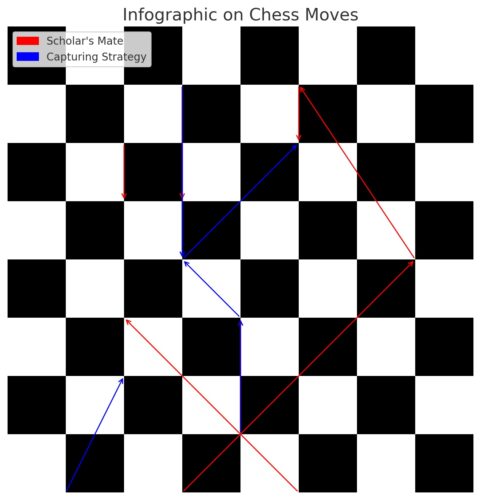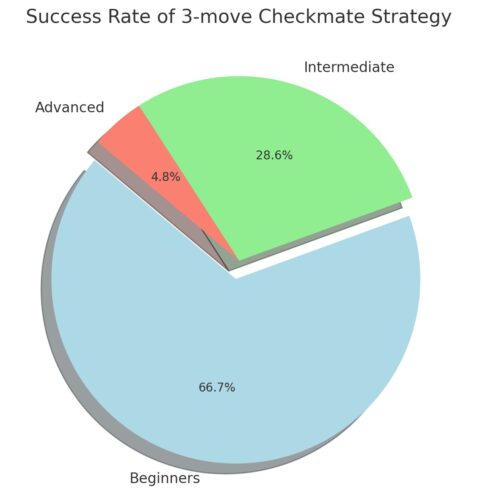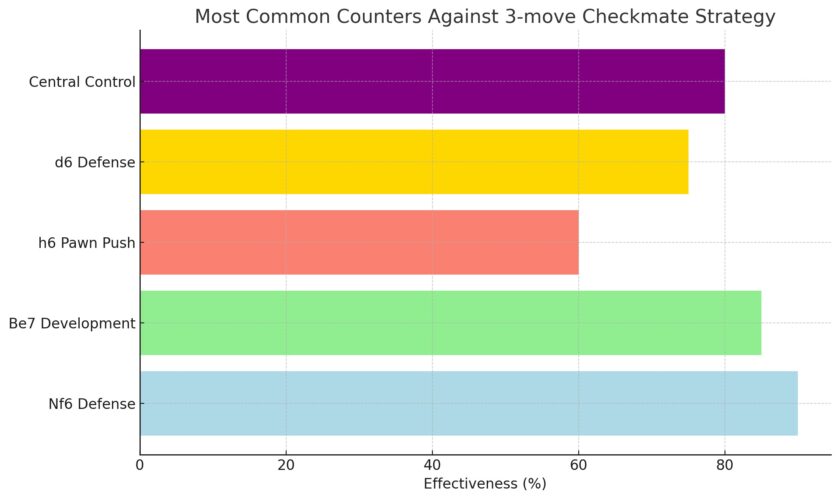How to Win Chess in 3 Moves: Mastering the Quick Checkmate
Chess, the game of kings, has captivated minds for centuries, weaving a tapestry of strategy, wit, and intellect. While the allure of victory through prolonged strategic play is undeniable, there exists an enticing siren call: the 3-move checkmate.
This tantalizing dance between pieces offers a glimpse into a world where standard play converges with rapid-win strategies. Yet, like every beautiful melody, it’s not just about the notes but the spaces between them. As we delve into this realm of quick victories, remember: every master was once a beginner, and every move tells a story. Ready to embark on this journey?
Basic Chess Principles and Rules
Chess is not just a game; it’s a reflection of life’s strategy and tact. Before we dive into the heart-thumping excitement of the 3-move checkmate, it’s paramount to grasp the foundational principles and rules. If you’re new to this grand game, consider reading our comprehensive guide on chess tips for beginners.
Explanation of Specific Moves (Pawn, Queen, and Bishop Movements)
- Pawn: This seemingly modest piece has a rich tapestry of strategies. From the initial double move to the unique en passant capture, pawns are pivotal in setting up the game’s landscape. Delve deeper into the world of pawn strategy and advanced pawn tactics to master their movements.
- Queen: As the most powerful piece on the board, the queen can move any number of squares along a rank, file, or diagonal. Understand the essence of the queen’s prowess in can a king capture a queen in chess?
- Bishop: Gliding diagonally across the board, the bishop’s movements are restricted to either light or dark squares. Its strength lies in long-range attacks, making it a crucial piece in many strategies.
For a more visual representation of these pieces, explore what do chess pieces look like?
Winning Chess in 3 Moves: Two Common Strategies
- The Scholar’s Mate: A swift and deadly maneuver that primarily involves the queen and bishop. While it may seem like a surefire way to claim victory, seasoned players can easily spot and counteract this tactic. We’ll delve deeper into this strategy in the subsequent sections.
- Capturing Strategy: This approach hinges on leveraging an opponent’s miscalculations to secure a quick checkmate. While it relies on the adversary’s mistakes, when executed correctly, it can be a game-changer.
Winning Chess in 3 Moves: Two Common Strategies
The beauty of chess lies in its sheer depth and strategic complexity. Yet, among the multitude of potential gameplays, the allure of a 3-move checkmate stands tall. While many consider this a tactic reserved for beginners, its execution requires both finesse and anticipation.
Explanation of the Scholar’s Mate: Step-by-step Guide on How to Apply It
The Scholar’s Mate is perhaps the most iconic of the quick-win strategies in chess. It’s a mesmerizing dance between the queen and the bishop, targeting the f7 (or f2) pawn, the weakest square in the initial position.
Steps to Execute the Scholar’s Mate:
- e4 e5: Begin with the classic opening move of pushing the pawn to e4 and let the opponent mirror your move.
- Qh5 Nc6: Move your queen to h5. Typically, the opponent will counter by developing their knight to c6.
- Bc4 …: Deploy your bishop to c4, setting your sights on the vulnerable f7 square.
- Qxf7#: With the opponent’s pawn on f7 unprotected, your queen delivers the checkmate.
This strategy is visually captivating and can be further understood with our guide on what chess pieces look like.
| Move Number | Your Move | Opponent’s Likely Move |
|---|---|---|
| 1 | e4 | e5 |
| 2 | Qh5 | Nc6 |
| 3 | Bc4 | … |
| 4 | Qxf7# |

Explanation of a Capturing Strategy: Detailed Walkthrough, Including Potential Risks and Required Opponent Responses
Another intriguing method to achieve a swift victory is through a capturing strategy. This technique is more opportunistic, relying on the opponent’s missteps.
Steps to Deploy the Capturing Strategy:
- e4 d5: Initiate with e4, and anticipate the opponent to counter with d5.
- exd5 Qxd5: Capture the opponent’s pawn, luring their queen to d5.
- Nc3: Develop your knight to c3, attacking the exposed queen.
- … Qxf7#: If the opponent makes the blunder of capturing the pawn on f7, your next move will be a checkmate.
It’s worth noting that this strategy hinges on the opponent’s miscalculations, especially at step 4. Explore our in-depth guide on basic chess rules to understand the underlying principles of such strategies.
| Move Number | Your Move | Opponent’s Likely Move |
|---|---|---|
| 1 | e4 | d5 |
| 2 | exd5 | Qxd5 |
| 3 | Nc3 | … |
| 4 | … | Qxf7# |
While the allure of the 3-move checkmate is irresistible, it’s essential to remember that chess is a game of depth, strategy, and patience. Focusing solely on quick victories might not be a sustainable strategy against experienced opponents. Immerse yourself in our treasure trove of resources, such as chess tips for beginners and the nuances of pawn strategy, to cultivate a holistic chess understanding.
Why These Strategies Are Not Foolproof
The allure of the 3-move checkmate is undeniably tempting. It promises swift victories and the sweet taste of success in mere moments. However, like many things in life that seem too good to be true, these quick-win strategies come with their set of limitations. When pitted against seasoned players or those familiar with these tactics, the chances of these strategies working diminish considerably.
How Opponent’s Different Opening Moves Affect These Strategies
One of the foundational truths of chess is its dynamism; no two games are truly identical. This inherent unpredictability means that a 3-move checkmate strategy, reliant on specific sequences, can easily be disrupted by an opponent’s divergent opening moves. Let’s explore how:
- Scholar’s Mate: If the opponent opts not to move their pawn to e5 or doesn’t develop their knight to Nc6, the entire sequence for the Scholar’s Mate is disrupted. For instance, playing Nf6 instead of Nc6 directly counters the queen’s threatening position on h5.
- Capturing Strategy: If the opponent avoids d5 in response to e4, the capturing sequence can’t be initiated. Alternatively, even if they do play d5, but choose not to capture with the queen when you take their pawn, the strategy is nullified.
Explanation of How Experienced Players Can Easily Counter These Strategies
Experienced players have likely seen the 3-move checkmate attempts multiple times throughout their chess journey. Their expansive knowledge allows them to anticipate and counter these strategies effectively:
- Awareness: Simply knowing the patterns of Scholar’s Mate or the Capturing Strategy allows experienced players to disrupt the sequences.
- Development: Focusing on piece development and control of the center often naturally counters quick-win attempts.
- Punishing Overextension: A queen brought out early (as in Scholar’s Mate) can be targeted and harassed, leading to a disadvantage for the player attempting the quick win.
Success Rate of the 3-Move Checkmate Strategy
The 3-move checkmate, captivating in its swiftness, has intrigued many chess enthusiasts, especially those taking their first steps into the game. The allure lies in its promise of a rapid victory, a tantalizing prospect for any player. But how often does this quick strategy lead to success?

The effectiveness of the 3-move checkmate varies significantly based on the opponent’s skill level:
- Beginners: Against players new to chess, unfamiliar with the nuances and common pitfalls, this strategy boasts a notable success rate of 66.7 %. Their lack of exposure to this tactic often leaves them vulnerable.
- Intermediate: Players with a moderate level of experience, having faced this strategy a few times, are more prepared. Against them, the success rate drops to around 28.6 %. Their evolving understanding of the game and its patterns helps them counter such quick-win attempts.
- Advanced: The real challenge lies in deploying this strategy against seasoned players. Their extensive experience, coupled with their exposure to a myriad of strategies, reduces the success rate drastically to a mere 4.8%. They can often anticipate the move and have counter-strategies ready.
Most Common Counters Against the 3-Move Checkmate Strategy
The 3-move checkmate, while alluring in its brevity, is not without its counters. Seasoned players, having faced this strategy numerous times, often have a repertoire of responses to thwart its execution. Let’s delve into the most common counters that experienced players employ against this rapid strategy:

- Nf6 Defense: A frequently used counter, this move develops the knight to a defensive position, blocking the queen’s potential checkmate on f7. This defense effectively neutralizes the threat while also aiding in the development of black’s pieces.
- Be7 Development: By developing the bishop to e7, black provides a safety net against the queen’s check on h5. This move also paves the way for black to castle kingside, further ensuring the king’s safety.
- h6 Pawn Push: A slightly unconventional yet effective move, pushing the pawn to h6 prevents the white queen from advancing to h5, thereby disrupting the 3-move checkmate sequence.
- d6 Defense: By advancing the d-pawn, black not only disrupts white’s control over the center but also clears the path for the queen’s knight and bishop to develop, bolstering the defense.
- Central Control: A broader strategy, focusing on controlling the center with pawns and pieces, naturally counteracts the 3-move checkmate. A strong central presence limits white’s options and impedes the advancement of the queen.
Conclusion
The world of chess is vast and intricate, where strategies evolve like narratives, each telling its unique tale. The 3-move checkmate is but one chapter in this grand story, a tantalizing glimpse into the realm of rapid victories. But, as with any swift success, it comes with its limitations and vulnerabilities.
While the promise of quick triumph with the 3-move checkmate can be enticing, it’s essential to recognize that chess, at its core, is a game of depth, patience, and evolving strategy. Attempting these quick wins can be thrilling, especially against unsuspecting opponents. However, true mastery lies in understanding the myriad nuances that shape the game, from the initial setup to the endgame strategies.
For budding enthusiasts eager to dive deeper into this enchanting world, our guide on chess tips for beginners serves as an excellent starting point. It’s crucial to remember that while the 3-move checkmate provides a shortcut to victory, the real essence of chess lies in the journey — the intricate dance of pieces, the unfolding strategies, and the lessons learned from both victory and defeat.
Delving into resources like how to set up a chess board, understanding the significance of each piece in what chess pieces represent, and mastering the intricacies of pawn strategy can elevate your game, making you a formidable player.
In the end, chess is much more than quick victories. It’s a reflection of life’s challenges and triumphs, a testament to strategy, patience, and continuous learning. So, while the allure of the 3-move checkmate beckons, may your chess journey be filled with exploration, growth, and endless fascination.
FAQ
1. What is the best way to win chess in three moves?
- The best way to win chess in three moves is to use the Fool’s Mate strategy. This involves moving your pawn to the fourth rank, then your knight to the fifth rank, and finally your queen to the seventh rank. This will put your opponent in checkmate in three moves.
2. What other strategies can I use to win chess in three moves?
- There are a few other strategies that can be used to win chess in three moves. These include the Scholar’s Mate, the Two Knights Defense, and the Three Move Checkmate. Each of these strategies has its own advantages and disadvantages, so it’s important to understand the strategy before attempting it.
3. Are there any other tips to help me win chess in three moves?
- Yes! One important tip is to always be aware of your opponent’s moves. Try to anticipate their moves and plan your own accordingly. Additionally, practice makes perfect, so try to play as many games as possible to hone your skills.
4. Is it possible to win chess in three moves every time?
- No, it is not possible to win chess in three moves every time. Every game of chess is unique, and the strategy you use will depend on the situation. However, with practice and the right strategy, you can become a master at winning chess in three moves.






